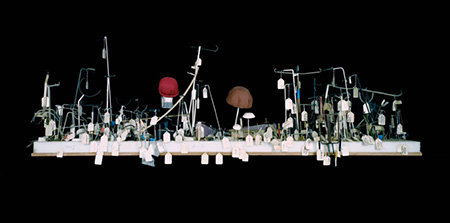
Continuing through October 6, 2018
Catherine Wagner is one of a select group of Bay Area photographers (including Richard Misrach, Michael Light and David Maisel) who use photography to examine the contemporary world and the social forces and institutions shaping it. Social-document factuality joins with art photography’s formalist rigor. Unlike her peers, however, Wagner does not focus on the anthropogenic natural landscape, but the indoor, man-made landscape; with some exceptions, she depicts scientific and cultural artifacts, savoring their beauty, while remaining at least ostensibly neutral in tone, befitting photography’s once-vaunted mechanical objectivity. Charlotte Cotton in “The Photograph as Contemporary Art” coined the term ”deadpan aesthetic.” Wagner lets us draw our own conclusions from image and title without editorializing.
This richly diverse show draws from a number of series produced over the artist’s forty-year career, starting with “Early California Landscapes” (1974-8), semi-abstract views of construction sites. “The Moscone Site” (1978-81) documents the construction of Moscone Center (named after the late mayor) and Yerba Buena Center, which replaced the old working-class neighborhood south of Market Street and presaged today’s dot-com gentrification. The subject of “The Architecture of Reassurance” (1995), the dream world of Disney parks, casts light on their cultural infantilizing. A contrasting sombre tone infuses “American Classroom” (1985-6), depicting empty classrooms across the country, with their uniform desks and blackboards.
“Art & Science: Investigating Matter” (1995) shifts Wagner’s attention from man-made structures to a study of scientific samples, collections and their storage facilities, based on a fresh interest in the Human Genome Project. Her engagement with technology emerges again in “Museum Pieces: Trilogy: Reflections on Frankenstein, the Arctic Circle and the History of Science” (2003), here juxtaposing Arctic landscapes of Romantic desolation and grandeur with 1950s scientific models and the foil-wrapped Frankenstein-monster devices (actually vacuum chambers) used at Stanford National Accelerator Laboratories.
Going behind the scenes lends a documentary aspect to Wagner’s work, as in the focus of “Reclassifying History” (2005) on the ‘backstage’ practices of art curators and technicians at San Francisco’s deYoung Museum during its move from the old neoclassical building to its contemporary quarters. But some of her projects simply demonstrate an abiding curiosity that translates seemingly obscure subjects into powerful aesthetic stories. “A Narrative History of the Lightbulb” (2006) delves into a typology of lightbulb evolution (which includes an homage to Yves Klein’s International Klein Blue). “trans-literate” (2012-3) is a study of Braille books, closed and open, in diptych form. “Rome Works” (2014) returns Wagner to her earlier interest in museum curation and preservation issues through the classical artworks made available to her during a Rome Prize Fellowship.
One of the most memorable individual images here is “Double X Construction (Early California Landscape),” with the witty rhyming of X forms in 2 by 4 inch bracing repeated in the taped glass of the windows behind. “Arch Construction IV (Moscone Site)” is a dramatic wide-angle view of a roller-coaster-like incline and scaffold anchored by an L-shaped section of densely packed, almost solid rebar. “Emerson College, Southwick Hall, Boston MA (American Classroom)” composes empty, laminated-plywood writing desks facing a trio of blackboards, one of which bears a large, scrawled inscription: I DON’T KNOW.” In “Columbus, Penelope, Delilah (Re-Classifying History)” a trio of marble statues of historical and mythological figures rest on pallets or in crates, are silhouetted against a black curtain. “Artemis/Diana (Rome Works)” centers our attention on a headless, legless marble torso set atop a pedestal and lashed into place by nylon strapping that matches in color the enameled steel of a portable scaffold that frames the view of the goddess like a theater’s proscenium arch.
Wagner’s photography is both the portrait of a temperament and a window on the world.
